Saying that a film version of Cloud Atlas is an ambitious project is like saying that translating Midnight’s Children into Zulu when you don’t know the language is an ambitious project. It’s not ambitious, it’s kind of impossible. Yet the Wachowskis and Tom Tykwer did just that in 2012.
This is a complicated one. Let’s work through it together.
The author of Cloud Atlas, David Mitchell, was supportive of the film in perhaps that most understanding way he could possibly be; he acknowledged at length that film and literature are different animals, and that translating his book was bound to be a trial, but that he trusted the filmmakers to know their own craft well enough to make the transition work. He reported to be pleased with the final result.
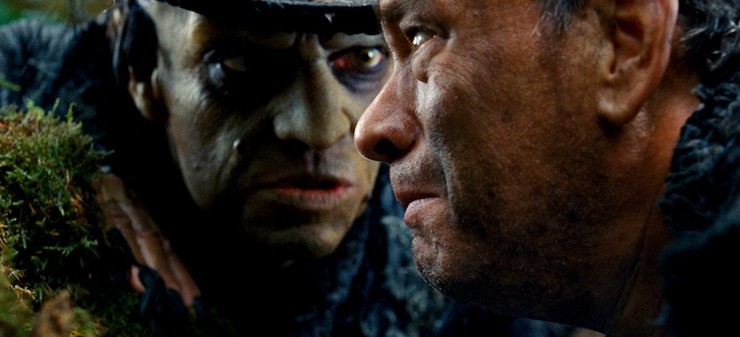
This film is extraordinary. But it also fails. It is an evocative, imperfect beast of a movie. It is the sort of work that demands multiple viewings in order to fully disseminate it, but we don’t live in a world where people generally want that out of their viewed entertainment. Still, I appreciate this film for the fact that it forces its audience to engage fully, to think, to be confused and try again. That doesn’t mean that it succeeds; Roger Ebert—who fully enjoyed the film—said that he realized on a second viewing that he’d never fully understand the thing because it doesn’t quite make sense. But, like everything that the Wachowskis are involved with, it is a beautifully unique piece of art told in six interwoven parts.
There are parts that are not so beautiful, of course. This film came under fire for the yellow face prosthetics that it put on its white actors, and for good reason. In the interest of examination, the yellow face was not the only race-bending done in the film; Doona Bae plays both a white and a Mexican woman in different eras of the story, Halle Berry (who is herself a biracial woman) also plays a white woman and an Indian woman, as well as a native of the Pacific Islands. The appearance of the actors during the section set in the 24th century on the Big Isle of Hawaii are also altered with prosthetics in some cases, though we are not given clear indication of what anyone’s heritage is. In addition, several actors change genders with the use of prosthetics and makeup.
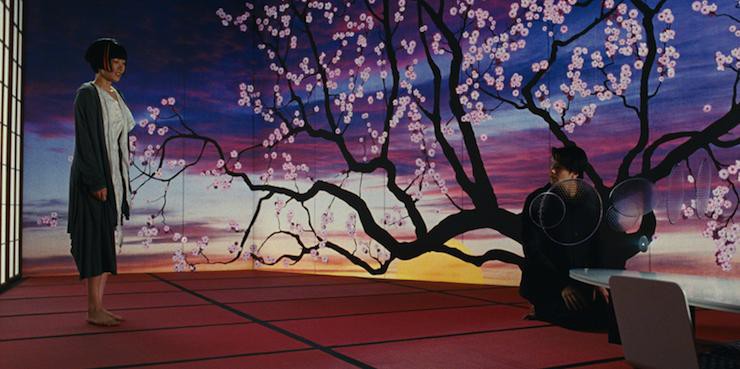
On one hand, the impulse is understandable from a creative standpoint. This is a story about interconnected lives, and the choice to reuse the same primary cast in each different era of the story works toward a fascinating (if sometimes difficult to catch) cohesion. The problem is simple: in most of these eras within the story, the primary characters are white or black, and merely using protheses to look a little different, to offer an altered visual cue. In the Neo Seoul section, however, all of the characters should be Korean, and the primarily white cast is prompted to wear prosthetics to address the issue. It’s an entire section of the narrative that suddenly resorts to whitewashing in effort to preserve the creative impulse of a consistent cast. Perhaps, if the cast had been more diverse in the first place, if they had cast more Asian actors in the core group, this wouldn’t be so glaring of a move. But the prosthetics for the actors in Neo Seoul look awful, on par with Old Hollywood’s whitewashing of Asian characters using actors like Alec Guinness and Micky Rooney.
The fact that there is technically (and I almost feel like I should put the words in quotation marks, as it’s hard not to be sarcastic about it) a logistical reason for this whitewashing doesn’t make it work, doesn’t prevent it from reading as sloppy and offensive. Frankly, the overlapping cast is something that I imagine might work better in theatre than on a big screen —and in theatre, all the prosthetics wouldn’t have been necessary. You would simply give your audience a program with the actor’s name and each character they were going to play, and ask the audience to buy your conceit. This sort of experimentation with multiple roles often works better on stage. It wouldn’t automatically absolve the directors of responsibility here; the actors should still be an incredibly diverse group for such a move to work in casting. Cloud Atlas does a relatively good job on this front, but over half of the main cast are still white men. In some ways, we could argue that the novel itself is partly to blame for this problem in casting, as at least half of the narrative sections are centered on white male characters, but there are plenty of primary supporting roles that could have gone to POC actors.
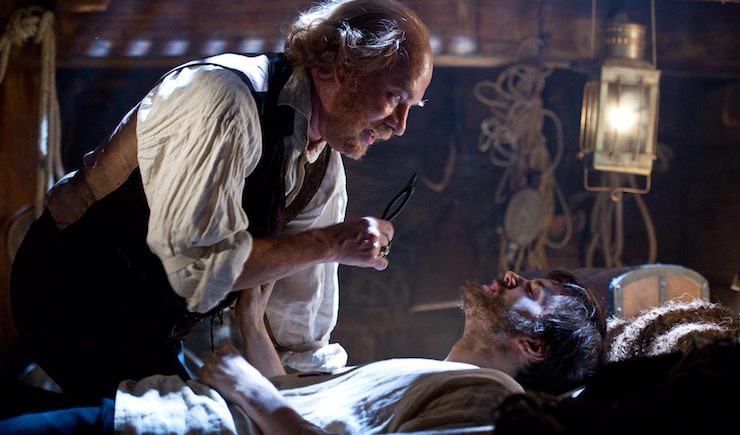
And it’s really too bad that it doesn’t work out in the long run, because asking these actors to play multiple characters truly does enrich the film. While the focal characters in each section are clearly connected by their shooting star birthmark, the reappearance of the same actors as supporting characters lends itself to a certain aspect of rebirth or even reincarnation between these eras. Some of these people seem to grow and change, others are stuck in their given roles through each incarnation; Hugh Grant’s characters are always callous, cruel, and powerful, Hugo Weaving is always playing the forceful and dangerous long arm of the establishment, Doona Bae’s roles are women fighting on behalf of others to change unjust systems, James D’Arcy is mostly a sensitive and pensive soul. Certain sets of people seem to meet over and over, and have similar connections; Tom Hanks’s characters fall in love with Halle Berry’s more than once, Ben Whishaw and Jim Broadbent’s characters seem to cause each other pain whenever they meet. It makes for fascinating viewing that requires thoughtfulness and attention, that insists on audience awareness rather than a passive viewing experience.
The structure of the story is very much changed from David Mitchell’s novel, weaving each narrative together so that they run back and forth across each other. While the book moves forward in time and then back again to complete each story, the film uses overlap to increase tension, which makes sense for cinema and the emotional immediacy it often provokes. There are very few major changes to Mitchell’s story, the biggest one to my mind being the alteration of composer Robert Frobisher’s reason for committing suicide. In the book, it is because he has completed his masterpiece (the Cloud Atlas Sextet) and believes that there is nothing greater for him to achieve. In the film, it is because he is about to be outed by his former employer Vyvyan Ayrs. On the one hand, when half of the filmmaking team on this project are trans siblings, the choice to deal with the reality of LGBT+ lives and the threats and fears they’ve always had to face feels like an honest and meaningful effort. On the other hand, it’s disappointing that the only focal queer character in this story falls under the “tragic gay” trope by being persecuted for his sexuality. I have extremely mixed feelings about that particular change in the narrative. Ultimately, it seems to me that the change is made to narrow in on the themes of love that the Wachowskis always push to the forefront of every project; Frobisher’s love of Rufus Sixsmith becomes a far more important aspect to his life when the audience knows those desires ultimately lead to his demise.
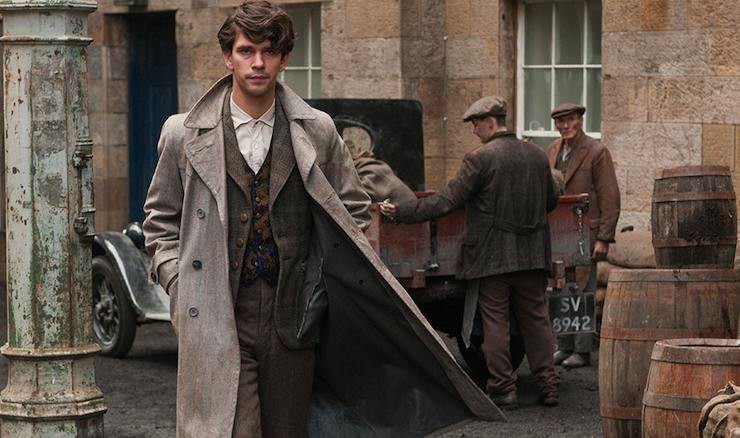
The movie is a visual feast of the highest order, filmed expertly and gorgeously designed in every detail. For that alone, the film deserves all the praise it garners. It’s impressive that while the project had two sets of directors, it feels cohesive stylistically as well. The music is superb, the Cloud Atlas Sextet itself being partially composed by codirector Tom Tykwer. The cast is phenomenal at articulating a variety of challenging roles. But like so many works the Wachowskis are involved with, no one could agree on whether Cloud Atlas should be lauded or maligned. It was simultaneously named one of the best and worst movies of 2012 by various respected voices and publications. I think it safe to say that the people who dismissed the film outright likely made no attempt to parse it out, but the primary cause for diverging opinion seemed to come down to whether or not you found the film emotionally affecting.
Because the story of Cloud Atlas is certainly not for the faint of heart. It is essentially six linked stories that turn on themes of human connection—ways to abuse those connections and ways to make them flourish for the benefit of all. Adam Ewing is being slowly murdered for his wealth by a dishonest doctor, Robert Frobisher is being used for his musical genius by Vyvyan Ayrs, Luisa Rey uncovers a plot to allow nuclear disaster for corporate benefit, Timothy Cavendish finds himself committed to a cruel nursing home by his own brother, Sonmi~451 learns that people (called “fabricants”) like her are created as slave labor, then ground up and fed to each other, Zachry keeps seeing visions of a nasty figure called Old Georgie, who encourages him to give into fears and keep the more advanced Prescient society at a distance, including the newly arrived Meronym.
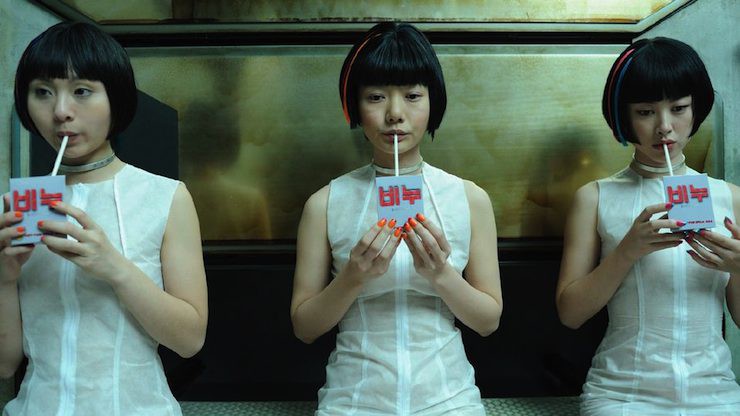
All of these stories show people using one another for profit and gain without consideration. Humanity at its worst in every sense, concerned only with power and oppression.
But then each narrative turns. Slowly, we begin to see how all of these stories can be altered for the better when people connect out of love, friendship, empathy. Because of his relationship with Autua, an escaped slave who saves his life, Adam Ewing and his wife leave for the North to become abolitionists. While Robert Frobisher’s life ends in tragedy, he completes his artistic masterpiece and loves Rufus Sixsmith until his last. Luisa Rey sticks to her guns, finds people who are willing to aid her at great personal risk and uncovers corruption, preventing environmental disaster and countless deaths, and inspiring her young neighbor to pursue a future as a mystery novelist. Cavendish makes friends in Aurora House, breaks out with them, writes his story, and reunites with the love of his life. Sonmi~451 finds a purpose and love among freedom fighters, and spends the rest of her short time sharing her story and awaking the masses. Zachry and Meronym come to trust one another and save the people left on Earth, moving them to a distant colony on a new planet. They fall in love and have a family, two very different people from two cultures that utterly distrusted each other.
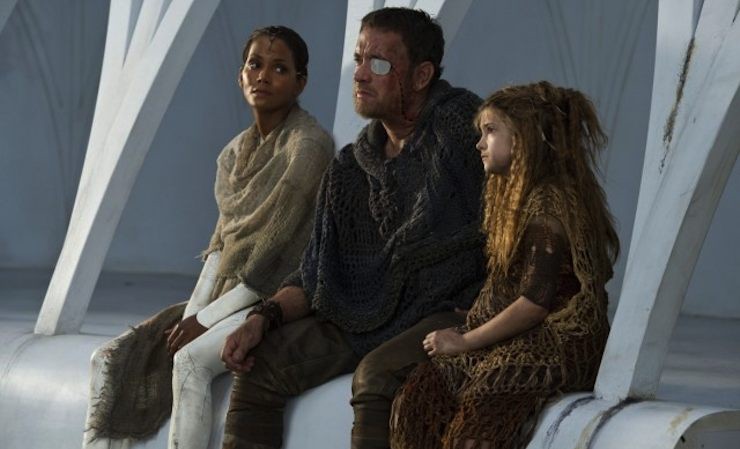
Humanity at its best. Unwilling to give in, loving and helping one another, uniting to protect each other. I suppose that’s why I don’t fully understand the critics who couldn’t emotionally converse with the film. The story is harrowing and sharp and full of pain, at times too dire to withstand… and then fans out into a tapestry of love, perseverance, and interdependence across time.
So Cloud Atlas doesn’t succeed in every aspect, but it manages in the place where it matters most—a reminder of what were, what we are, and what we might become.
Emmet Asher-Perrin spent a few sleepless nights rewatching this this film over and over the first time she saw it. You can bug her on Twitter and Tumblr, and read more of her work here and elsewhere.










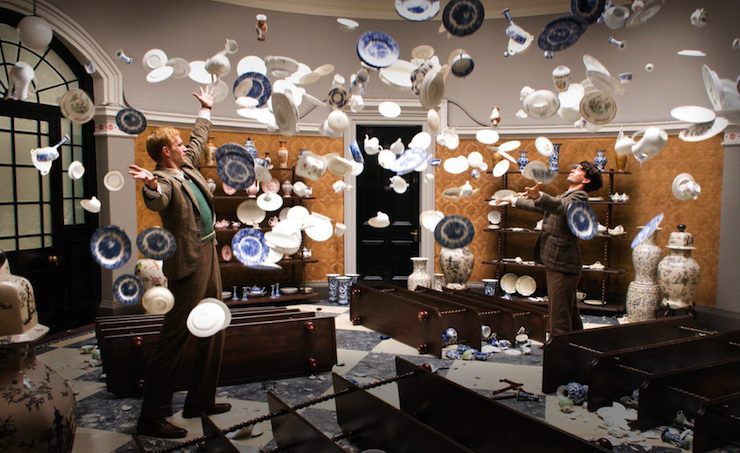
I saw the film and was astonished and blown away – I thought it was brilliant. Then I read the novel and had it happen again in a different way. I love both. Thanks for the commentary. I did not even think about the white-washing factor, but it’s hard for me to find quite as much fault as you do – even though I fully agree with the points you make! Of course, I am a white male, so maybe I’m just not able to have the perspective…
I loved the book and spent ages analyzing it, but had a strong aversion to the film. It just… didn’t work. It seemed to miss too many notes from the book. I especially disliked Zachry’s story (my favourite in the book after Frobisher’s), mostly because the staging, the costumes and sets reminded me of a cheapish Doctor Who episode or the funky klingons from early Star Trek. I can’t really put my finger on it, but even looking at that photo in the article makes me cringe. Post-apocalyptic crotchet-work and crimped hair? Not my thing.
I thoroughly enjoyed this film while my friend didn’t get it,or like it at all. I had to explain what was going on many times. I liked that they used the dame people for the different characters, it really showed how, just using Tom Hanks characters, they changed.
I see absolutely no problem with the whitewashing you mention. In fact, I’ve barely noticed it before.
I think it’s a product of the ever more so politically correct world certain groups or people are trying to force down everybody else’s throats. I’m convinced some even think laws should be invented just to portrait every damn race equally on screen.
Rubbish. The film was a brilliant nonsensical story. No need to find a flaw that isn’t there. The re-use of the actors in different characters is a necessity of the film, you gain nothing and lose much adding more actors of different races.
And I’m mexican.
This is one of my favorite films of the decade so far, and a demonstration, I think, that the Wachowskis haven’t really lost their touch, so much as maybe their audience. Wonderful, this one.
And while it is kind of a mundane or technical thing to focus on, this is an absolutely brilliant film from an editing standpoint. I don’t know how much of that can be credited to the source material, but for such a complex, interwoven tale to actually work and be follow-able is an astounding feat, pulled off here.
Yep, I really loved the book and liked the movie. As to the other stuff, seriously get over it. It’s called suspension of disbelief. We all understood why they did it, and it was not to make fun of Asian people. The examples you gave are apples and oranges. In one sentence you call this movie art and in the next you bash it for not being diverse enough. You can’t have it both ways. It made you uncomfortable? Good. Art is supposed to challenge us. This is something lost on many young people. The world is not smooth. It is full of hard corners and sharp edges.
Ugh, no thanks. The book is a clever set of nested narratives in different literary styles, but I don’t like dystopias or “mystery” stories, and those sections were nightmare fuel in the book; I don’t want to see them in film. The whitewashing and prosthetics, in this day and age, seal the deal for me.
That said, I believe it’s possible to criticize something and still consider it “art.”
A friend and I agreed that this would be a tough movie to watch in a theater, because of its length, and I suspect that’s some of the problem. I watched it on DVD, giving me time to pause and think.
You’re kind of right about the race issues—I didn’t notice them at the time, but then as a straight white male, they probably just didn’t make the kind of impression on me than they would on many people. I was nonetheless astounded at the end to find that so many actors had played so many different roles.
Great movie? I’m not sure. But certainly an interesting one—which is almost better than great.
I loved this film and have watched it a number of times with other people who have also thought it was great and some that said “uh – what was that about?”. Its one of those films you either get or you don’t but if you do get it then multiple watches are great as you just get more and more details all the time. Okay some of the plots are better than others but as a whole you are constantly thinking about the links between them.
True the whitewashing was there but as a white male it did not bother me that much as I realised there was a reason for this and I think it helped the narrative of the film by making it more clear that the same “soul” was effected in different periods. IF they had used different characters this link would have been lost.
“Disseminate”. I do not think that word means what you think it means.
To echo some of the other comments: I love this film. Without hesitation the best movie I’ve ever seen. I saw it several times in theaters and it’s the first movie that made me actually cry at the theater. I love everything about it. The actors, the music, the writing and the editing (can’t be understated how important this last on is). I understand why some people don’t like or get this movie, but it speaks to me in a way that few movies really do. I’m also a sucker for optimistic stories, and in the end, the movie is positive about humanity.
If I had to rank the Wachowski movies, I would go Cloud Altas > Speed Racer > The Matrix. I consider The Matrix to be a classic, but (some) of their follow up movies have been even better.
How many ways can you visually depict a person whose soul is shared among many characters, in many eras, of many races? (Hint: There aren’t many.) Now how many of those ways would actually work on a movie screen?
I understand why people are overtly-sensitive to the movie’s “whitewashing”; and yes, having a more diverse cast would have mitigated some of that sensitivity… but only in a superficial way, which—when you think about it—is the only basis for racial sensitivity in the first place. And if science fiction lovers can accept the conceit of humanoid aliens without cringing, why not this?
At any rate, it was easy for me to note the issue, consider the negative comments it would be put to, and summarily dismiss them in my effort to accept the movie’s concept and enjoy the stories. And enjoying them was easy, especially given the Wachowskis’ deft handling of the visual medium; I was fascinated from Minute One.
Comparing source material, especially a novel, to a film is futile. The very nature of film allows so much of what is written to be shown visually, and often it is exactly those descriptions of setting that make writing memorable.
I think a more apt comparison is to look at the previous work by the same filmmakers, specifically “V for Vendetta.” A cold, angry, cruel, bitter film. One of the only films I have ever walked out of because I felt the anger at the human race was palpable and I didn’t want to be horsewhipped for 2 hours.
Cloud Atlas was the complete opposite. I had given up on the Wachowskis, to be honest. I didn’t know what had happened but I wanted no part of it. Cloud Atlas took all that sadness, which believe me I can relate to, and triumphed over it. I loved the line about how enough drops of water make an ocean. That, to me, is the theme of the film. Eventually, even if goodness is merely a tiny drop in the face of evil, enough drops over time become an ocean. Fast, cheap and easy may win in the short term, but over time good endures. That is a beautiful message, flaws and all.
My then book club read “Cloud Atlas,” and all of the members plus one husband who read it and participated in discussion hated it. All of us read widely across genres, and our general consensus was that none of the parts of the book satisfied genre conventions or expectations (historical, mystery, science fiction). We found most of the characters distasteful or implausible or highly annoying. The consensus surprised me, because this was a group of very smart readers with widely varied taste. When we discussed other books, we never all agreed, even to the macro level of “Did we like this?” For that reason, none of us went to see the movie.
I really appreciate your outstanding commentary, Emily. I love both the movie and the book, and it’s great to see this film get such a thoughtful critical coverage. Your point about how the narrative turns as “all of these stories [are] altered for the better when people connect out of love, friendship, empathy” really hits the target. The film (and to some extent the book) were criticized by some for having a simplistic, superficial message that “everything is connected,” but I think your argument counters that criticism very well. The related but distinct themes — the one you mentioned, “all boundaries are conventions,” and drops and oceans — entangle throughout the film in powerful ways.
I completely agree with you about Frobisher’s “tragic gay” arc, but I must admit that I choke up every time when Sixsmith is looking for him at the top of the cathedral and later as Sixsmith arrives in his room. Those are touching moments, especially sad — as suicides usually are — for the needlessness of it. I suspect that the original arc/reasoning seemed too abstracted to evoke the film’s themes effectively, which might be why the filmmakers chose the route they did.
On the prosthetics etc., I understand what they were trying to do and why, but I feel that they made a poor choice, especially given the toxic history of that approach. I believe that it would have served their purposes at least as well to use an approach like one would in the theater, with the actors appearing as they are except for the clothes/accessories/hair/decorations of the character in question. The audience would have had to work a bit to imagine the actor as a character of that time, place, or gender (e.g., in New Seoul), but that wouldn’t be too hard (cf. Quantum Leap). I agree as well that cast diversity could have and should have been better. A more diverse cast would have furthered their underlying point, emphasizing our common humanity independent of origin or demographics.
But that said, I do wonder if the film deserved the full measure of criticism it got in this regard. I recognize that the history of how such prosthetics/make-up were used makes this approach quite reasonably taboo, but I think their reasoning should count at least a little to separate their efforts from that history. And it seems, though I could be wrong, that the cast was relatively diverse for the time by the (admittedly low) standards of Hollywood. But I’m not really qualified to gauge how offensive it was all told, so I’m uncertain.
Thanks again for your review of this and the other Wachowski films.
I love this movie very much and every time I watch it, I tear up a little. Just amazing and brilliant.